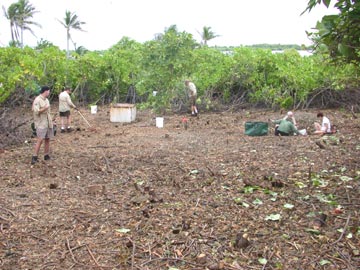|
|||
|
Earhart Project Research Bulletin #33 November 20, 2001 |
|||
|
|||
|
|||
 |
This was the Seven Site on Day 8 (September 5, 2001) of the Niku IIII expedition. The TIGHAR team was doing a final cleanup after a solid week of backbreaking clearing in hundred-degree heat. We were hoping that the archeological work that could now begin would justify the investment of time and sweat. We were not disappointed. | ||
|
In 1940, British Colonial Officer Gerald Gallagher found a partial human skeleton at a supposed castaway’s campsite somewhere on this end of the island. Our analysis of the available information about that discovery leads us to suspect that the castaway was Earhart and that the discovery was made at the place we call the Seven Site.Our methodology was designed to answer a number of questions:
Affirmative answers to some or all of these questions might confirm that we had found the place where the castaway had lived and died, but the biggest question was the last one:
Over the next twelve days, explorations and excavations at the Seven Site revealed a rich and complex array of hidden features. As with most archaeological sites, several kinds of activity over the years have left a jumble of evidence that must be carefully sorted out. It is apparent, for example, that a large water tank and a variety of construction materials were brought to the site by the colonists at some time, probably before the war. Also, during the war, American servicemen from the U.S. Coast Guard Loran station came to the site on one or more occasions for informal target practice with their .30 caliber M-1 carbines (as evidenced by numerous shell casings and the shattered remains of at least two ceramic plates, one of which bears the Coast Guard logo). However, not all of the artifacts can be reliably ascribed to these known activities – quite the contrary. |
|||
Click on each topic to read our results and reasoning, and to see photographs of the artifacts recovered:
| |||

